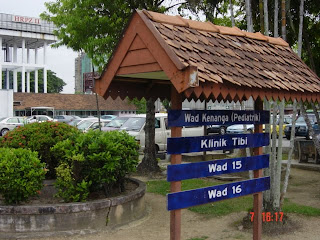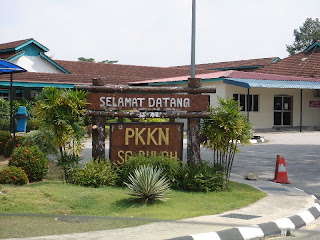Hospital Kuala Krai (HKK), Kuala Krai, Kelantan
Address:
Pengarah Hospital
Jalan Kuala Krai
18000 Kuala Krai
Phone: 09-966 6333
Fax: 09-966 6076
Address:
Pengarah Hospital
Jalan Kuala Krai
18000 Kuala Krai
Phone: 09-966 6333
Fax: 09-966 6076
Kuala Krai was a British stronghold and administrative capital. It prospered because of the iron mines farther ahead at Bukit Besi (according to locals, mining has ceased and mines abandoned). Iron was transported by train down south for export to Great Britain. (Iron mining was also carried out in Terengganu - from accounts of my father, of his uncle (Pak Busu/my Tok Busu) who married and settled in Jengka, Pahang after WWII.
Hospital Kuala Krai (HKK) was the first hospital built by the British in Ulu Kelantan district. It is located on a hilltop. The main road passes in front of the hospital and leads to the main entrance at the foothill. The Gua Musang highway is behind the hospital and not visible from the hospital. (Google Earth may show the location of HKK wrt the Gua Musang highway.)
All photos by Faridah Abdul Rashid.
New entrance to HKK.
Rear carpark.
Ambulance route (from entrance uphill to A&E).
Front carpark, A&E and ambulance bay.
Front carpark (nearest ambulance bay).
Ambulance bay and main ward building.
Main road to HKK and Kuala Krai town (farther up ahead).
A telecommunication tower can be seen in the middle background.
Delivery unit. This is an old building.
Old entrance to HKK has been closed off.
Old part of HKK. The staircase leads up to the old offices above.
View of new HKK buildings from the old entrance (closed off).
HKK viewed from the main road.
YM Tan Sri Dato’ Seri Dr Raja Ahmad Noordin bin Raja Shahbuddin was an early Malay doctor who served at HKK. He was the only doctor in the then 80-bedded hospital in 1958, for 9 months. His patients were mostly Muslims. He contributed to the building of a small "surau" (just a platform) for the patients' families to perform their prayers. That "surau" is no longer there. There are two prayer places today - a wooden surau in front of the ambulance parking bay and a new brick surau near the rear parking lot.
New wooden surau.
New brick surau at the rear parking lot.
http://www.panoramio.com/photo/86803438
http://www.worldcam.pl/11085,en,sat





















































